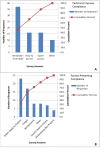Multifaceted interventions to decrease mortality in patients with severe sepsis/septic shock-a quality improvement project
- PMID: 26500811
- PMCID: PMC4614979
- DOI: 10.7717/peerj.1290
Multifaceted interventions to decrease mortality in patients with severe sepsis/septic shock-a quality improvement project
Abstract
Despite knowledge that EGDT improves outcomes in septic patients, staff education on EGDT and compliance with the CPOE order set has been variable. Based on results of a resident survey to identify barriers to decrease severe sepsis/septic shock mortality in the medical intensive care unit (MICU), multifaceted interventions such as educational interventions to improve awareness to the importance of early goal-directed therapy (EGDT), and the use of the Computerized Physician Order Entry (CPOE) order set, were implemented in July 2013. CPOE order set was established to improve compliance with the EGDT resuscitation bundle elements. Orders were reviewed and compared for patients admitted to the MICU with severe sepsis/septic shock in July and August 2013 (controls) and 2014 (following the intervention). Similarly, educational slide sets were used as interventions for residents before the start of their ICU rotations in July and August 2013. While CPOE order set compliance did not significantly improve (78% vs. 76%, p = 0.74), overall EGDT adherence improved from 43% to 68% (p = 0.0295). Although there was a trend toward improved mortality, this did not reach statistical significance. This study shows that education interventions can be used to increase awareness of severe sepsis/septic shock and improve overall EGDT adherence.
Keywords: Critical care; ICU; ICU mortality; Quality initiative; Sepsis; Surviving sepsis.
Conflict of interest statement
The authors declare there are no competing interests.
Figures
Similar articles
-
Could a protocol based on early goal-directed therapy improve outcomes in patients with severe sepsis and septic shock in the Intensive Care Unit setting?Indian J Crit Care Med. 2015 Mar;19(3):159-65. doi: 10.4103/0972-5229.152759. Indian J Crit Care Med. 2015. PMID: 25810612 Free PMC article.
-
Early goal-directed resuscitation for patients with severe sepsis and septic shock: a meta-analysis and trial sequential analysis.Scand J Trauma Resusc Emerg Med. 2016 Mar 5;24:23. doi: 10.1186/s13049-016-0214-7. Scand J Trauma Resusc Emerg Med. 2016. PMID: 26946514 Free PMC article.
-
[The incidences of organ dysfunction in the early resuscitation of severe sepsis and septic shock patients:a retrospective analysis].Zhonghua Wei Zhong Bing Ji Jiu Yi Xue. 2016 May;28(5):418-22. Zhonghua Wei Zhong Bing Ji Jiu Yi Xue. 2016. PMID: 29920036 Chinese.
-
The Effect of Early Goal-Directed Therapy on Outcome in Adult Severe Sepsis and Septic Shock Patients: A Meta-Analysis of Randomized Clinical Trials.Anesth Analg. 2016 Aug;123(2):371-81. doi: 10.1213/ANE.0000000000001278. Anesth Analg. 2016. PMID: 27049857 Free PMC article. Review.
-
Early goal-directed therapy in the management of severe sepsis or septic shock in adults: a meta-analysis of randomized controlled trials.BMC Med. 2015 Apr 3;13:71. doi: 10.1186/s12916-015-0312-9. BMC Med. 2015. PMID: 25885654 Free PMC article.
Cited by
-
Early management of sepsis with emphasis on early goal directed therapy: AME evidence series 002.J Thorac Dis. 2017 Feb;9(2):392-405. doi: 10.21037/jtd.2017.02.10. J Thorac Dis. 2017. PMID: 28275488 Free PMC article. Review.
-
Development and performance of a novel vasopressor-driven mortality prediction model in septic shock.Ann Intensive Care. 2018 Nov 22;8(1):112. doi: 10.1186/s13613-018-0459-6. Ann Intensive Care. 2018. PMID: 30467807 Free PMC article.
-
Early goal-directed therapy in severe sepsis and septic shock: insights and comparisons to ProCESS, ProMISe, and ARISE.Crit Care. 2016 Jul 1;20(1):160. doi: 10.1186/s13054-016-1288-3. Crit Care. 2016. PMID: 27364620 Free PMC article. Review.
-
Outcome after intubation for septic shock with respiratory distress and hemodynamic compromise: an observational study.BMC Anesthesiol. 2021 Oct 25;21(1):253. doi: 10.1186/s12871-021-01471-x. BMC Anesthesiol. 2021. PMID: 34696738 Free PMC article.
-
Evidence Underpinning the Centers for Medicare & Medicaid Services' Severe Sepsis and Septic Shock Management Bundle (SEP-1): A Systematic Review.Ann Intern Med. 2018 Apr 17;168(8):558-568. doi: 10.7326/M17-2947. Epub 2018 Feb 20. Ann Intern Med. 2018. PMID: 29459977 Free PMC article.
References
-
- Coba V, Whitmill M, Mooney R, Horst HM, Brandt MM, Digiovine B, Mlynarek M, McLellan B, Boleski G, Yang J, Conway W, Jordan J. Resuscitation bundle compliance in severe sepsis and septic shock: improves survival, is better late than never. Journal of Intensive Care Medicine. 2011;26:304–313. doi: 10.1177/0885066610392499. - DOI - PubMed
-
- Dellinger RP, Carlet JM, Masur H, Gerlach H, Calandra T, Cohen J, Gea-Banacloche J, Keh D, Marshall JC, Parker MM, Ramsay G, Zimmerman JL, Vincent JL, Levy MM, Surviving Sepsis Campaign Management Guidelines C Surviving Sepsis Campaign guidelines for management of severe sepsis and septic shock. Critical Care Medicine. 2004;32:858–873. doi: 10.1097/01.CCM.0000117317.18092.E4. - DOI - PubMed
-
- Dellinger RP, Levy MM, Rhodes A, Annane D, Gerlach H, Opal SM, Sevransky JE, Sprung CL, Douglas IS, Jaeschke R, Osborn TM, Nunnally ME, Townsend SR, Reinhart K, Kleinpell RM, Angus DC, Deutschman CS, Machado FR, Rubenfeld GD, Webb S, Beale RJ, Vincent JL, Moreno R, Surviving Sepsis Campaign Guidelines Committee including The Pediatric S Surviving Sepsis Campaign: international guidelines for management of severe sepsis and septic shock, 2012. Intensive Care Medicine. 2013;39:165–228. doi: 10.1007/s00134-012-2769-8. - DOI - PMC - PubMed
LinkOut - more resources
Full Text Sources
Other Literature Sources


